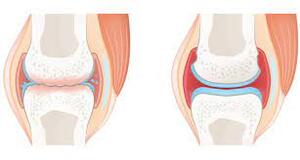More from dipalee dhokiya
More in Politics
Related Blogs
Les archives
Partage Social
Arthritis and osteoarthritis: know the differences
Corps
WHAT ARE THEY?
Both are rheumatic diseases that cause pain, that affect one or several joints and that are more frequent in women than in men. Although that is what they have in common, both their origin and their treatment are very different.
Arthritis is an inflammation that affects the synovial membrane. In this disease, the synovial fluid, which serves to lubricate, spreads throughout the joint instead of being reabsorbed as normal, causing constant erosion of the bone and cartilage. This pathology, which may or may not be chronic, is usually the consequence of other diseases and, therefore, encompasses many parallel alterations, such as rheumatoid arthritis, psoriatic arthritis, infectious arthritis or gout.
For its part, osteoarthritis is a chronic degenerative process that affects the cartilage, that is, the pad that is between the bones of the joint and that serves to prevent them from rubbing. Over time, the cartilage tends to disappear, causing friction to occur directly between bones, causing a lot of pain and loss of flexibility in the joints.
WHAT ARE THE CAUSES?
Arthritis can be due to many different causes. It can be due to infections caused by germs that reach the joint, trauma caused by a strong blow, autoimmune diseases, such as rheumatoid arthritis, or crystal deposits that accumulate in the synovial membrane (this is what popularly known as gout).
Osteoarthritis is usually associated with aging and is more common after the age of 40. However, there are other factors, such as obesity or overexertion of the joint, so typical of elite athletes, or some jobs with repetitive movements.
WHAT SYMPTOMS DO THEY PRODUCE?
Although both can affect any joint in the body, the location of the arthritis will depend on the type. For example, rheumatoid arthritis attacks the wrists and fingers more, and gout generally affects the feet, ankles and knees. Osteoarthritis, on the other hand, is located mainly in the hands, knees, hips, spine and feet.
Pain is also expressed differently. While with arthritis it is constant, with osteoarthritis there is more pain when moving the joint and it usually improves when it is left at rest.
In arthritis the joints are hot, red and swollen, and over time they can also become deformed. In osteoarthritis, the joints "creak" when moved, and in advanced stages they become deformed and lose mobility.
Another difference between both diseases is that many types of arthritis are accompanied by weight loss, tiredness, fever, among others, while osteoarthritis only affects the joints.
HOW ARE THEY DIAGNOSED?
There is no specific test to diagnose arthritis, but it will depend on the type of inflammation that the doctor thinks the patient may be suffering from. Sometimes a wide variety of tests are needed to reach a sure diagnosis, such as blood tests or analysis of fluid from the swollen joint.
Osteoarthritis is diagnosed by the symptoms and by the physical examination performed by the doctor. An X- ray helps, but it may be that there is osteoarthritis and normal X-rays come out and, vice versa, that the X-ray shows a lot of osteoarthritis, but that joint does not hurt. Therefore, the fundamental thing is the clinical picture.
HOW ARE THEY TREATED?
The basis of arthritis treatments is anti- inflammatory and joint rest. Other treatments will depend on the cause. Antibiotics are used in infectious disease, and corticosteroids or disease-modifying antirheumatic drugs, such as those containing methotrexate and biosimilar drugs, are used in rheumatoid and psoriatic disease.
Osteoarthritis has no cure, so treatments aim to reduce pain and improve mobility and function of the joint. To do this, it is key to avoid obesity and perform physical exercise appropriate to the age of the person and the affected joint. If it is the knee, for example, low-impact exercises, such as swimming or walking, are beneficial. As for drugs, none slows down osteoarthritis, but to treat pain, analgesics, such as paracetamol, and anti- inflammatory, such as ibuprofen, are recommended.
What is the recovery period after a joint replacement?













commentaires